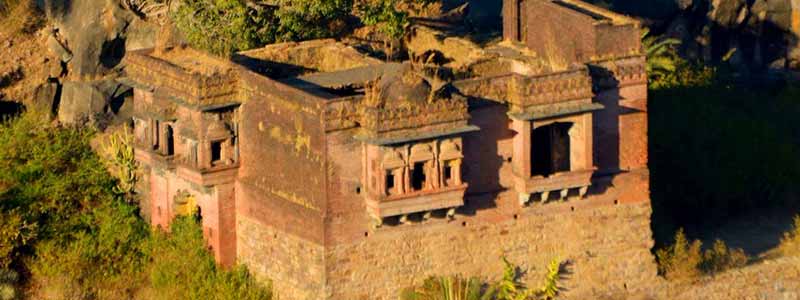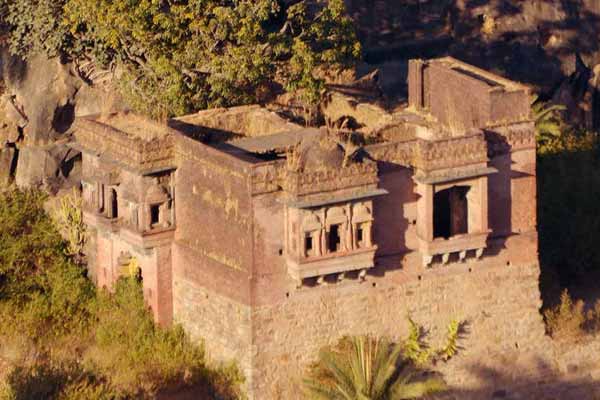Achalgarh Fort Mount Abu is the right place. Achalgarh Fort is one of the famous forts built in Mount Abu, Rajasthan (a state in India). This fort was originally built by the ruler of the Paramara dynasty and was later occupied by Maharana Kumbha. The year of origins is still unknown as the fort was later reconstructed and renovated by Maharana Kumbha who changed the fort’s name to Achalgarh Fort in 1452 CE.
Apart from historic representation, this fort is also famous for its religious connection as the Achaleshwar Mahadev temple dedicated to lord shiva and Nandi is located alongside the fort. The idol of Lord Shiva is located in this temple where the brass idol of Nandi can also be found. There are other Jain temples present within the vicinity of the fort, inside and outside the fort. These Jain forts were built a few years after the fort was built, in the year 1513.
Although the Achalgarh Fort Mount Abu plays an important role in the history of the state Rajasthan, This fort is now in ruins due to severe sandstorm and other weather conditions, not preserving the fort led to the dilapidated condition it is in now.

History of Achalgarh Fort
The Achalgarh Fort was renovated and fortified by Maharaja Kumbha to escape pillagers. The Achaleswar Mahadeva Temple is nearby where a toe of Lord Shiva is worshipped. You can find some Jain Temples inside the fort. The fort is in a run-down condition now. The first gate of the fort is known as Hanumanpol, which served as the entrance to the lower fort. It comprises two towers built of large blocks of grey granite. After some ascent, stands Champa pol, the second gate of the fort, which served as the entrance to the inner fort.
The decayed Achalgarh Fort Mount Abu is indeed a great architectural delight.There are some features of historical and religious importance in and around the fort.
Religious significance also makes Achalgarh Fort important owing to the renowned Achaleshwar Mahadeva Temple situated just outside the fort, along with the Jain temples which were built in 1513 within the fort premises. The Achaleshwar Temple is also well-known for containing a Nandi idol that is said to be made of 5 metals, namely, gold, silver, copper, brass and zinc and weighs more than 4 tonnes. Achaleshwar Temple also encloses a natural Shivalinga which symbolizes the ultimate creative power Mount Abu Tour Packages.
Near the fort is the beautiful Mandakini Lake, which is encircled by rocky hills, and rock walls with images of a Rajput king and buffaloes representing characters from a legend which tells that once the lake was filled with ghee and the watering hole of demons were disguised as buffaloes until they were shot by Raja Adi Pal Achalgarh Fort Mount Abu.
Attractions Near Achalgarh Fort
Achaleshwar Mahadeva temple is just outside the fort; the toe of Lord Shiva is worshipped there and a brass Nandi is also located there. The famous Nandi containing is said to be made of 5 metals, fold, silver, copper, brass, and zinc. The Nandi is made up of Panchadhattu and weighs more than 4 tons. There are also many other sculpted idols which are made of a crystal-like stone called sfatik.
The temple is surrounded by the Mandakini Lake. This lake is surrounded by rocky hills, and rock walls covered with images of a Rajput king and buffaloes. Near the temple, there are three stone buffaloes standing around a pond which is said as demons in stories. Achalgarh Fort Mount Abu is an impressive fort also with some beautiful Jain temples enclosed within. Among the important one is Kantinath Jain Temple.
From the center of Mount Abu Tourism town take Delwara Road. At Shwetambar Jain Temple and Dharamshala, continue onto Dilwara Rd then continue on Oriya Road . Then continue straight past Oriya Bus Stop onto Achalgadh Road and you will reach the Achalgarh Fort Mount Abu.
How to Reach Achalgarh Fort
The Achalgarh Fort Mount Abu is about 7 kilometres from the Main Bus Stand of Mt. Abu. If you want to avail the railway services, then the nearest station is at Abu Road which is situated at the base of Mt. Abu and is 37 km away. If you want to reach Mt. Abu via flight or would like to choose air travel, then the nearest Airport is 184 kilometres away in Udaipur. Other modes of transport such as private taxis and private bus services are also available.
